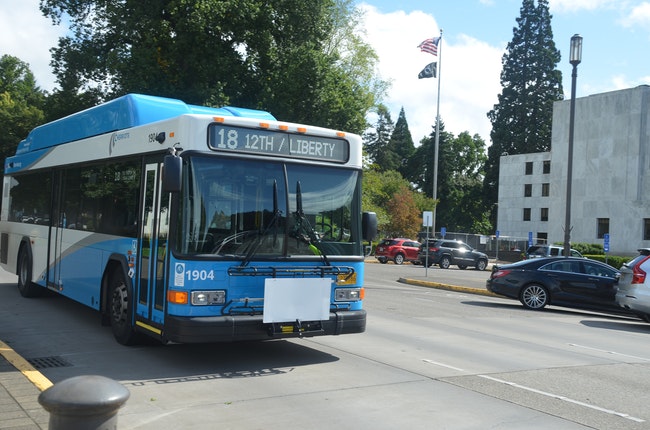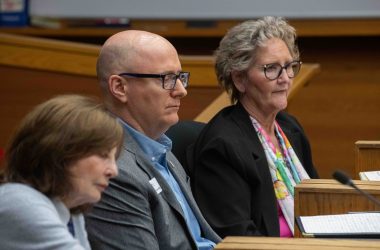 A Cherriots bus on State Street outside the Oregon Capitol (Rachel Alexander/Salem Reporter)
A Cherriots bus on State Street outside the Oregon Capitol (Rachel Alexander/Salem Reporter)
Salem’s public transit system is getting up to speed.
Come next year, fewer Cherriots buses will be delayed, and riders will have the ability to check the status of their bus in real time.
Cherriots received a $1 million grant from the Federal Transit Administration last month to improve bus service and plans to coordinate with Salem and the Oregon Department of Transportation to extend green lights when buses are running behind schedule.
The grant is helping the transit system install equipment that will upload buses’ locations every five seconds to better update its mobile app, website and information signs at its transit centers.
It’s a technology used in transit systems all over the world.
[ Help build Salem Reporter and local news – SUBSCRIBE ]
Steve Dickey, Cherriots’ director of strategic initiatives and program management, said the projects have been planned for more than a decade but never materialized due to lack of funding.
Dickey didn’t have a date for the launch of the real-time bus tracking. He said it would likely come before they build a new system that allows buses to talk to traffic lights.
The traffic signal project will be done in phases along a sequence of corridors, where traffic jams and stop lights lasting two minutes can make it difficult for buses to get back on schedule, Dickey said.
Signals on Northeast Lancaster Drive from State Street to Northeast Cooley Drive are a priority for Cherriots, Dickey said.
Another congested area Cherriots is eyeing is Southeast Commercial Street from Southeast Mission Street to Kuebler Boulevard.
“That front bus isn’t arriving every 15 minutes, and then you just missed the last one and the next one isn’t getting there for 30 minutes. It’s a problem for reliability and dependability on the system,” he said.
Dickey said the transit system has gotten multiple complaints for its lack of real-time tracking data and that Cherriots is trying to reduce uncertainty by making the changes.
He said numerous studies have demonstrated when people have a better assurance of knowing when the bus is going to arrive, they’re more likely to use transit even when they have other means of transportation.
“It is that sense of feeling comfortable knowing when that bus is coming really helps you feel confident in using it,” Dickey said.
Have a tip? Contact reporter Saphara Harrell at 503-549-6250, [email protected] or @daisysaphara.









